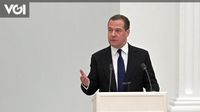In a dramatic escalation of tensions between the United States and Russia, the Kremlin has officially withdrawn from the Intermediate-Range Nuclear Forces (INF) Treaty, a landmark arms control agreement that has helped keep nuclear-tipped missiles out of Europe since the end of the Cold War. The move, announced by Russian President Vladimir Putin on August 8, 2025, follows a series of heated exchanges between former U.S. President Donald Trump and senior Russian officials, and comes at a moment when the war in Ukraine is reaching a critical juncture.
The immediate spark for Russia’s exit from the INF Treaty was President Trump’s public threat to deploy two nuclear ballistic missile submarines into Russian territory. According to The National Interest, this threat was issued in response to provocative statements by Dmitry Medvedev, Russia’s former president and current deputy chairman of the National Security Council. Medvedev, well known for his confrontational rhetoric, had engaged in a social media spat with Trump, warning the West to prepare for a "new reality."
Medvedev’s message, posted on August 5, 2025, made Russia’s position clear: "The Russian Foreign Ministry's statement regarding the lifting of the moratorium on the deployment of medium and short-range missiles is the result of the anti-Russian policy of NATO countries. This is a new reality that all our opponents must face. Look forward to the next steps," he wrote, as reported by VOIR éGALEMENT and other outlets.
Russia’s Foreign Ministry echoed Medvedev’s warning in a formal statement, declaring that Moscow would no longer consider itself bound by a moratorium on the deployment of short- and medium-range nuclear missiles. The ministry cited the deployment of U.S.-made ground-launched INF-range missiles in Europe and the Asia-Pacific as the primary reason for ending the self-imposed restriction. According to Nexstar Media, the ministry stated: "Since our repeated warnings in this regard have been ignored and the situation is developing along the path of the actual emplacement of the US-made ground-launched INF-range missiles in Europe and the Asia-Pacific, the Russian Foreign Ministry has to state that the conditions for maintaining a unilateral moratorium on the deployment of similar weapons have ceased to exist."
This decision marks the official end of Russia’s participation in the INF Treaty, which was originally signed in 1987 by U.S. President Ronald Reagan and Soviet leader Mikhail Gorbachev. The treaty banned land-launched missiles with ranges between 500 and 5,500 kilometers (311 to 3,418 miles), eliminating an entire class of nuclear weapons from the European theater. While the United States withdrew from the treaty in 2018—primarily due to China’s non-participation and concerns over Russian compliance—Russia had continued to observe its terms, hoping for renewed negotiations or a broader agreement. That hope has now evaporated.
With the treaty dead, Russia wasted no time in taking advantage of its newfound freedom. President Putin ordered the immediate deployment of intermediate-range ballistic missiles (IRBMs), including the advanced Oreshnik hypersonic weapon, into Belarus—a Russian ally and neighbor of Ukraine. This is the first time since the end of the Cold War that such weapons have been positioned in Europe. According to The National Interest, the Oreshnik has now achieved full-rate production and is available in significant numbers, giving Russia a major technological edge. There is currently no Western defense capable of reliably intercepting hypersonic missiles like the Oreshnik, placing European capitals and Kyiv squarely within Moscow’s crosshairs.
The timing of these deployments is no coincidence. At the start of the summer, Russia moved 160,000 fresh troops and a large array of military vehicles to the frontlines in Ukraine, signaling the launch of a new summer offensive. Now, with Oreshnik hypersonic missiles stationed in Belarus, Russia is threatening to rain down devastating firepower on Kyiv and other Ukrainian targets unless the government in Kyiv capitulates. The situation is dire: Ukraine’s air defense grid, battered by more than three years of war, is ill-equipped to withstand such an onslaught.
Meanwhile, diplomatic efforts to halt the slide toward catastrophe continue, albeit with little optimism. Representatives from Trump’s team and Putin’s government are meeting in Moscow for what both sides describe as a last-ditch attempt to salvage peace before Ukraine faces the prospect of total defeat. According to Nexstar Media, Trump’s special envoy, Steve Witkoff, is expected to travel to Russia for talks on August 6 or 7, 2025. Trump himself has called this the Kremlin’s "last chance" to reach a deal before new U.S. sanctions take effect.
President Trump, who has repeatedly called for an end to the war in Ukraine, spoke with Ukrainian President Volodymyr Zelensky on August 5, 2025. The two leaders discussed the situation on the ground, potential sanctions against Russia, and ongoing efforts by European nations to supply Ukraine with weapons. Zelensky, in a social media post, emphasized the importance of bilateral defense cooperation with the United States, noting that a draft agreement on drone technology was ready for negotiation and could become "one of the strongest agreements" between the two countries.
While the world watches nervously, the Russian Foreign Ministry has made it clear that decisions on the specific parameters of its response will be determined by the Kremlin, based on interagency analysis of Western missile deployments and the broader evolution of international security. As the ministry stated, "Decisions on the specific parameters of response measures will be made by the leadership of the Russian Federation based on interagency analysis with regard to the scope of the deployment of the US and other Western ground-launched INF-range missiles, as well as to the overall evolution in the area of international security and strategic stability."
For many observers, the current standoff is the culmination of years of mounting mistrust and tit-for-tat escalation. The U.S. withdrawal from the INF Treaty in 2018 was driven as much by concerns over China’s growing missile arsenal as by alleged Russian violations. Russia, for its part, maintained the moratorium in hopes of a broader agreement, but has now reversed course in the face of what it perceives as Western intransigence and direct threats to its security. Foreign Minister Sergey Lavrov had hinted as early as December 2024 that Moscow would respond to what it called "destabilization measures" by the U.S. and NATO.
As the pieces move into place for what could be a decisive phase in the Ukraine conflict, the stakes could hardly be higher. The deployment of Russian hypersonic missiles to Belarus and the collapse of the INF Treaty mean that Europe faces a nuclear threat it has not seen in decades. With neither side showing much appetite for compromise, and with the fate of Ukraine hanging in the balance, the world is left to wonder whether cooler heads will prevail—or whether the ghosts of the Cold War are about to return with a vengeance.
Only time will tell if the ongoing talks in Moscow can pull the region back from the brink, but for now, the specter of nuclear escalation looms larger than it has in a generation.




